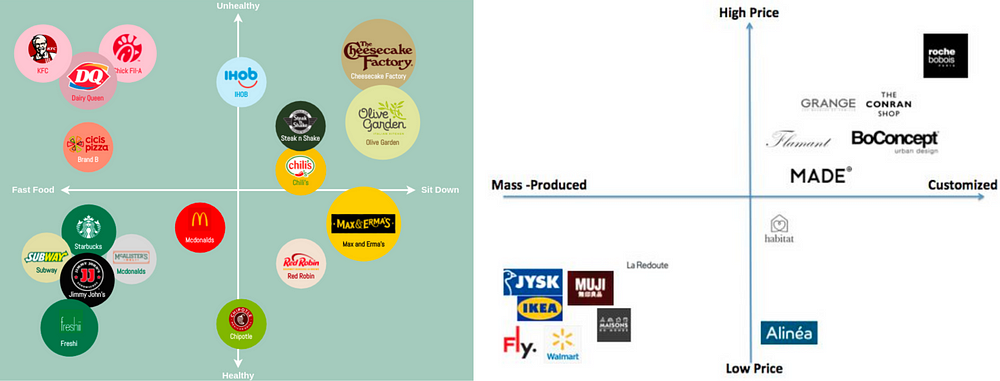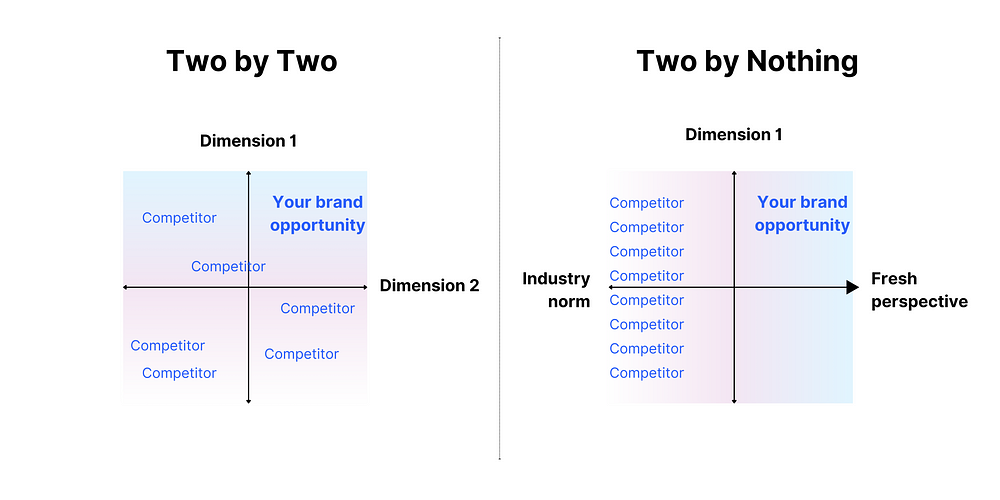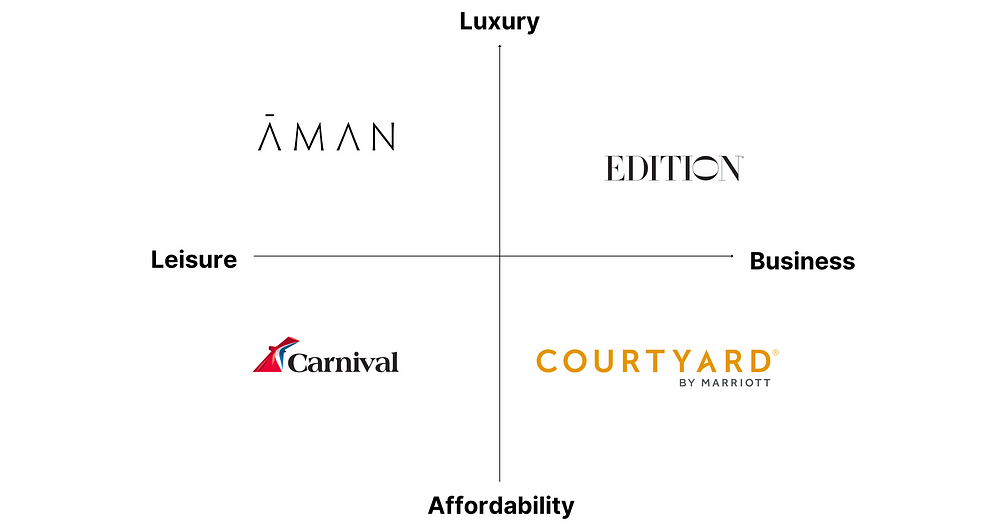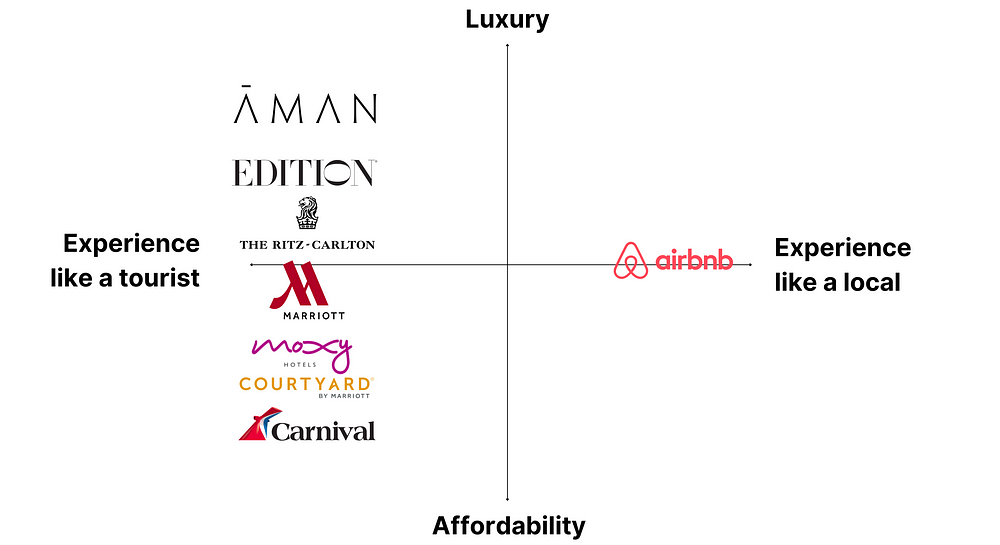Goodbye two by two. Hello two by nothing.A framework for building distinctive brands
A common brand strategy framework is the perceptual map. It’s a two by two matrix that organizes where your brand is perceived to be positioned along two dimensions. Perceptual maps are a great way to identify a gap in the market (to be filled by your brand, obviously) and/or diagnose what needs to change in order to have a more competitive positioning. Perceptual maps in fast food and furniture industries. Sources linked.
Perceptual maps in fast food and furniture industries. Sources linked.
However, when it comes to inspiring truly differentiated brands, the best framework isn’t a two by two. It’s a two by nothing. Let me explain.
A two by two shows how your brand fares in the combination of two desired dimensions on the market. Cheap AND high quality. Excellent. That’s good market positioning, sure. But if you’re looking for a differentiated brand positioning, an idea that can own a role in culture and inspire differentiated marketing in a crowded category — you don’t want to convey how your brand sits at the combination of features other brands also offer. You want to show the world (or at least your creative team) that your brand is different. It’s in a category all on its own. It’s not just ‘the high quality version’ of something that already exists. It’s a new category altogether. Two by Two perceptual map vs a Two by Nothing. Source: Michelle Wiles
Two by Two perceptual map vs a Two by Nothing. Source: Michelle Wiles
The Two by Nothing takes all your competitors and shows what they are fighting over — price, quality, etc… and then reveals that you are playing another game altogether.
Take places to stay and Airbnb. A typical perceptual map might look like this: Places to stay perceptual map. Source: Author
Places to stay perceptual map. Source: Author
If you were to add in Airbnb, it would likely be somewhere on the left side. Accurate? Yes. Informing? Also yes. Inspiring for standout marketing? No. But if you start from the assumption of a Two by Nothing, your challenge shifts from How do we show that Airbnb is the best combination on the market? To, How do we position Airbnb on a new plane altogether? Places to stay Two by Nothing. Source: Author
Places to stay Two by Nothing. Source: Author
Suddenly. Airbnb isn’t just a place to stay. It’s a way to experience a new place. Airbnb’s Chef’s Kitchens campaign is rooted in the idea that an Airbnb is a completely fresh experience:
Airbnb: Chef’s Kitchens
Airbnb’s latest campaign aims to convey Airbnb as the best way to travel with friends. You could easily position all hotels and cruise lines along a horizontal dimension that goes from separate rooms to stay together (with Airbnb as the sole brand in the stay together category).
Airbnb: Stay together for less
In essence, the Two by Nothing is a way to raise the bar for your marketing. It’s not enough to be better on one metric. A standout brand requires rethinking the category altogether.
How do you create a two by nothing for your brand?
1. Map the competition
Like the typical perceptual map process, start with researching the market. Identify your top competitors and substitutes. What features do they provide? Why do people use them? How do customers evaluate options? What are the important differentiators? You can segment your competition many ways — price, features, healthiness, seriousness, taste, style, usage occasion and start to score them.
2. Uncover insights around your brand and audience
Interview your brands’ founders, executives, marketers, product managers, customers, and front line workers. How do they describe the company? Your mission? Your products? There are a lot of creative questions that can help get to the root of your brand and your audiences’ needs. What do employees believe? Why did the founder create said organization? If your brand was to organize a protest, what would be the subject? The goal here is to start to understand how your brand or company can be positioned separately from others.
It’s possible your company isn’t doing anything that different from other brands in the category from a pure product perspective. That’s okay. One can differentiate through marketing and values. Look at Liquid Death. It’s ‘just’ water, but their marketing, packaging, and values convey something akin to an energy drink. Corona isn’t a beer; it’s a vacation in a bottle.
3. Position your brand on a new plane to your competition
Here is what you start to think laterally. What do all companies in the category have in common? What are the industry norms that people do not even think about anymore, because they are so ingrained? E.g. All hotel rooms must be standardized. All Swiss timepieces are expensive, rigid devices. All flip flops are flimsy and designed for the beach. At the same time, consider what you found out in step 2. What’s a category reframe your brand can provide? It might take some back and forth between steps 2 and 3 to arrive at a differentiator that is ownable and valuable to your audience.
Once you find it, place all your competition on one side, and choose a horizontal axis that demonstrates that your offering is something completely new. A Swatch isn’t a rigid timepiece, it’s a flexible fashion accessory. A Kenner isn’t a sandal, it’s an open streetwear sneaker.
Want to position your brand as a new category?
I run brand consultancy Embedded — where I partner with founders and C-suite executives to unlock brand growth with category defining brand strategy.
Not sure where to start? Many clients opt for ad-hoc coaching — hourly consultations on any aspect of your marketing and brand strategy. Get in touch here, or book a 15 minute free consultation.
















































![RichBeak News [RU]:OKX, Binance и Bybit запустили торги NotcoinКрупнейшие криптобиржи, включая OK](https://cdn.bulbapp.io/frontend/images/9f0d3fdf-7aca-4ef5-bc8e-ab4f3a7c1f48/1)


